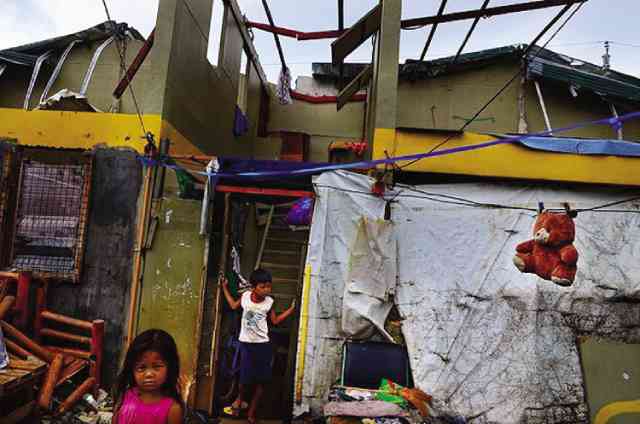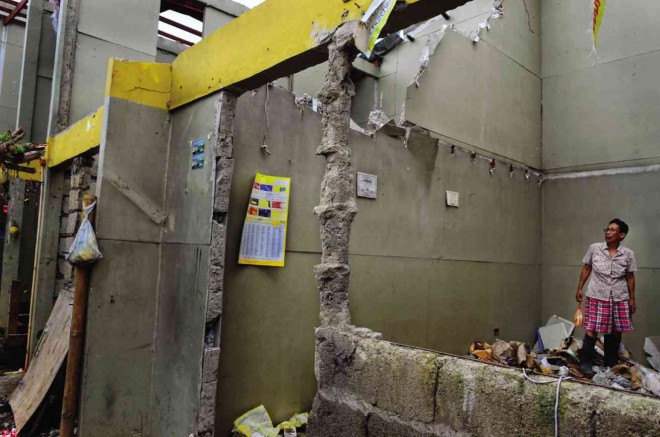After storm, a low-cost housing redesign

THEY are among the thousands of people relocated at the National Housing Authority Southville 7 in Calauan, Laguna province, when Tropical Storm “Ondoy” struck in 2009. Recently, Typhoon “Glenda” made a direct hit on the site. AL BENAVENTE/CONTRIBUTOR
CALAUAN, Laguna—Pregnant for seven months, 21-year-old Cristina Rubinas opened a tiny store—actually, a wooden table with plastic jars of candies, a few packs of crackers, and cheap junk food—in front her family’s temporary shelter.
This was the least she could do while waiting for their house to be rebuilt. “The stores are also far from us. Now it would be quite a walk for me,” she said.
Rubinas’ family lived in Southville 7, a 107-hectare resettlement site of the National Housing Authority (NHA) subdivided into three zones in Calauan town in Laguna province.
The housing project, popularly called Bayanijuan, was meant for thousands of illegal settlers who were relocated from Manila and survivors of Tropical Storm “Ondoy” (international name: Ketsana), which swept the metropolis in 2009. It has been comanaged by the NHA and ABS-CBN Foundation since 2009.
Private foundations
Article continues after this advertisementFunding came from private foundations, such as San Miguel Corp. and Zonta International Foundation. Some of the houses were built by Habitat for Humanity, a volunteer group, while others were put up by private contractors.
Article continues after this advertisementRubinas, her husband Ryan, 25, and her two sons, ages 4 and 5, lost their house when Typhoon “Glenda” (international name: Rammasun) swept through Laguna and the rest of southern Luzon on July 16.
“We huddled inside the bathroom as the wind blew away the roof and the walls. We were scared, but the kids had their father on the phone, telling him he needed to buy us a new house and a television set because the typhoon destroyed them,” Rubinas recalled.
Ryan was away that day to work on construction projects in Manila.
Days after, they had to bundle up their belongings again and move into one of the unoccupied units, several blocks away from their original house. The unit they had been occupying since 2009 was razed by a fire.
The typhoon also destroyed the two-story learning center from an insurance company, Sun Life Financial Philippines, that was inaugurated just last April. The 55 units that Don Bosco borrowed from the NHA to be used for classes and other activities were not spared.
Lost houses
On Monday, the Bayanijuan deputy project manager, Miko Aliño, said 209 houses, mostly in Sites 1 and 3, were destroyed and rendered “no longer livable,” while 225 others were damaged.
Susan Pullarca, a volunteer organizer of the Don Bosco community chapel, said 339 houses were destroyed and 1,203 were damaged, based on her group’s assessment. The three sites have a total of 5,544 houses.
No one was reported killed or hurt.
“The materials were flimsy. The steel used was too thin. How could that withstand the wind?” Ryan said.
“Apparently, they scrimped on the materials,” said Ramon Vibar, 59, another settler.
Maricar Perjes, 25, who moved into a relative’s unit last November, said the sound of the wind ripping off the roof reminded her of Supertyphoon “Yolanda” (international name: Haiyan) when she and her family were in Tacloban City in November last year.
“We were shaking. We hid under the bed because the ceiling might collapse. I was thinking: Am I that bad to be punished with two storms?” she said as she cradled her year-old daughter.
“The materials were quite weak, but it was hard to judge if they were substandard. [The structures] withstood [Tropical Storm] ‘Basyang’ (2014), but not [Glenda’s] 200-kilometer-per-hour wind so there could be many factors (as to why the houses collapsed),” Don Bosco priest Boy Pablo said.

HOUSES made of steel frame and cement board collapsed at the height of Typhoon “Glenda” in a government resettlement site in Calauan, Laguna province. The destruction prompted officials of the low-cost housing program to revisit the houses’ structural design. AL BENAVENTE/CONTRIBUTOR
Steel-framed
Aliño said the types of houses in Southville 7 were those made of steel frame and cement board, a design used for the earlier cluster of houses built (estimated construction cost per unit: P75,000), while the other types used concrete interlocking blocks (CIB) for the walls (estimated cost per unit: P90,000).
Most of those that collapsed were the steel-framed ones built by Habitat for Humanity.
“We understand such remarks. It is a low-cost housing [project], but we’re trying to fully assess [the damage] so this would not happen again,” Aliño said.
Two days after the storm, Aliño said, Bayanijuan stakeholders had met to assess the damage, prompting a revisit of the houses’ structural designs.
The NHA, which owns the lots, moved the families temporarily to the unoccupied units, while ABS-CBN Foundation “is taking care of them,” Susana Nonato, Southern Tagalog deputy area management officer, said in a phone interview on Tuesday.
Habitat for Humanity has committed to rebuild the houses using stronger materials that would be “typhoon-resilient,” Nonato said.
“We also asked Habitat [for Humanity] to hire people from the affected families for the construction as a form of livelihood,” she said.
‘Confluence’ of factors
New houses would be built, using CIB, while the damaged ones would be reinforced, Aliño said. Reconstruction could take three to four months.
Charlie Ayco, Habitat for Humanity managing director and chief executive officer, believed a “confluence of factors” had caused the houses to collapse.
“Was it the function of the materials? Was it the design (of the houses)? Or was it that wind was just too strong?” he said in a phone interview on Wednesday.
Of the 890 houses built by the humanitarian group, only 70, which used a steel frame for the basic structure, collapsed, Ayco said. Habitat for Humanity said it would reconstruct 130 houses to include those whose structures withstood the wind but lost the roofs or walls.
Where are lofts?
The damaged units, Ayco said, were “loftable,” meaning they were about 4 meters high and which the homeowners should have “reinforced” by building a loft. These were also the units located on open, vacant spaces, with no other structure to block the wind.
“These houses (built as early as 2009) followed the Philippine Building Code, which was to withstand winds of 160-180 kph. It was only after Yolanda that President Aquino gave a directive [that houses should withstand] 250-kph wind,” the Habitat for Humanity official said.
A similar design for the houses had also been used in several other housing projects. In fact, Ayco said, the same technology was used to build duplex houses in a Department of Social Welfare and Development project in St. Bernard, Southern Leyte province, and the houses withstood Yolanda.
“The houses had gone through several typhoons but still, we have to learn from this,” he said. Habitat for Humanity encourages volunteers and sometimes the homeowners themselves to do the light work in the construction, although the riskier parts of the job are done by skilled laborers.
Ayco said they would be using CIB and would adjust the height of the structures to make them sturdier.